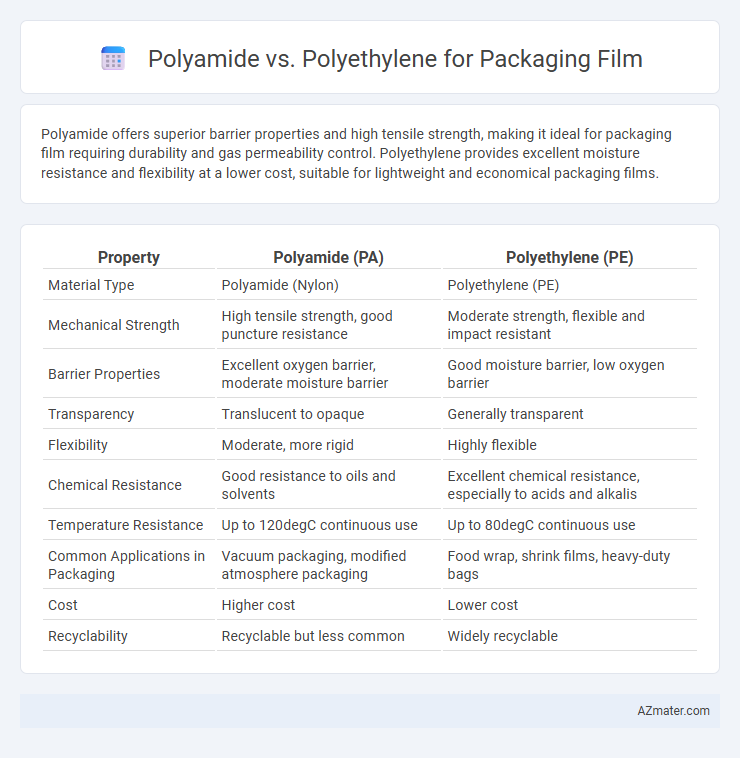Polyamide offers superior barrier properties and high tensile strength, making it ideal for packaging film requiring durability and gas permeability control. Polyethylene provides excellent moisture resistance and flexibility at a lower cost, suitable for lightweight and economical packaging films.
Table of Comparison
| Property | Polyamide (PA) | Polyethylene (PE) |
|---|---|---|
| Material Type | Polyamide (Nylon) | Polyethylene (PE) |
| Mechanical Strength | High tensile strength, good puncture resistance | Moderate strength, flexible and impact resistant |
| Barrier Properties | Excellent oxygen barrier, moderate moisture barrier | Good moisture barrier, low oxygen barrier |
| Transparency | Translucent to opaque | Generally transparent |
| Flexibility | Moderate, more rigid | Highly flexible |
| Chemical Resistance | Good resistance to oils and solvents | Excellent chemical resistance, especially to acids and alkalis |
| Temperature Resistance | Up to 120degC continuous use | Up to 80degC continuous use |
| Common Applications in Packaging | Vacuum packaging, modified atmosphere packaging | Food wrap, shrink films, heavy-duty bags |
| Cost | Higher cost | Lower cost |
| Recyclability | Recyclable but less common | Widely recyclable |
Introduction to Polyamide and Polyethylene
Polyamide (PA), known for its exceptional mechanical strength, chemical resistance, and barrier properties, is widely used in packaging films that require durability and resistance to punctures. Polyethylene (PE), one of the most common plastics, offers flexibility, moisture resistance, and cost-effectiveness, making it ideal for films used in food packaging and general-purpose applications. The choice between polyamide and polyethylene depends on specific requirements for strength, barrier performance, and environmental exposure in packaging solutions.
Chemical Structure and Composition
Polyamide (PA) packaging films consist of long chains of amide groups (-CONH-) in their backbone, resulting in strong intermolecular hydrogen bonding that enhances mechanical strength and barrier properties. Polyethylene (PE) films are composed of repeating ethylene monomers (-CH2-CH2-) with a non-polar hydrocarbon chain, providing excellent moisture resistance but lower gas barrier performance compared to polyamide. The presence of polar amide groups in polyamide distinguishes its chemical structure from the non-polar hydrocarbon nature of polyethylene, directly impacting their functionality in packaging applications.
Mechanical Strength and Durability
Polyamide (PA) films exhibit superior mechanical strength and abrasion resistance compared to polyethylene (PE), making them ideal for packaging requiring high puncture resistance and durability. Polyamide's enhanced tensile strength and excellent resistance to chemical degradation ensure longer-lasting protection of goods, especially in demanding environments. Polyethylene films, while flexible and moisture-resistant, generally offer lower mechanical strength, making them better suited for lightweight or short-term packaging applications.
Barrier Properties: Oxygen and Moisture Resistance
Polyamide (PA) exhibits superior oxygen barrier properties compared to polyethylene (PE), making it ideal for packaging applications requiring extended shelf life and protection against oxidation. Polyamide's high moisture resistance is moderate but often enhanced with coatings or multilayer structures, whereas polyethylene provides excellent moisture barrier performance but lower oxygen resistance. Combining PA and PE in multilayer films optimizes overall barrier performance, balancing oxygen and moisture resistance for versatile packaging solutions.
Flexibility and Processability
Polyamide (PA) offers superior flexibility and puncture resistance, making it ideal for packaging films requiring durability and adaptability. Polyethylene (PE), especially low-density polyethylene, excels in processability due to its lower melting point and ease of extrusion, allowing faster production speeds and cost efficiency. The choice between PA and PE for packaging film hinges on balancing PA's mechanical strength with PE's efficient manufacturability.
Temperature and Chemical Resistance
Polyamide films exhibit superior temperature resistance, maintaining structural integrity up to 150degC, making them ideal for high-heat packaging applications. Polyethylene films typically withstand lower temperatures, around 80-90degC, but offer excellent chemical resistance to acids and bases, suitable for general packaging needs. The enhanced barrier properties of polyamide against gases complement polyethylene's resistance to moisture, providing options based on specific thermal and chemical exposure requirements.
Printability and Surface Characteristics
Polyamide (PA) films offer superior printability due to their higher surface energy, which enhances ink adhesion and results in sharper, more vibrant graphics compared to polyethylene (PE) films. The surface characteristics of polyamide include greater rigidity and chemical resistance, making it ideal for high-quality packaging that requires detailed printing and durability. Polyethylene films exhibit lower surface energy, often requiring surface treatment like corona or plasma to improve printability and achieve acceptable ink adhesion.
Environmental Impact and Recyclability
Polyamide packaging film offers excellent barrier properties but poses challenges in recycling due to its chemical complexity and incompatibility with common polyethylene recycling streams. Polyethylene film is more environmentally friendly with higher recyclability rates and greater acceptance in existing recycling infrastructures, resulting in lower overall environmental impact. Choosing polyethylene over polyamide helps reduce plastic waste accumulation and supports circular economy initiatives in packaging.
Cost Comparison and Market Availability
Polyethylene packaging film generally offers a lower cost compared to polyamide, due to its simpler polymer structure and widespread production methods. Polyamide films, known for superior barrier properties and durability, typically command higher prices and may have more limited availability in certain markets. Market availability favors polyethylene, which dominates packaging applications globally, while polyamide is preferred for specialized uses requiring enhanced protection.
Ideal Packaging Applications for Polyamide vs Polyethylene
Polyamide packaging film is ideal for applications requiring high mechanical strength, excellent barrier properties against oxygen and aromas, and superior puncture resistance, making it suitable for vacuum-packed meats and cheese. Polyethylene film excels in applications needing moisture resistance, flexibility, and cost-effectiveness, such as food wraps, produce bags, and shrink films. Combining these materials in multilayer films leverages polyamide's barrier and strength with polyethylene's sealability and moisture barrier, optimizing protection and shelf life.

Infographic: Polyamide vs Polyethylene for Packaging Film
 azmater.com
azmater.com